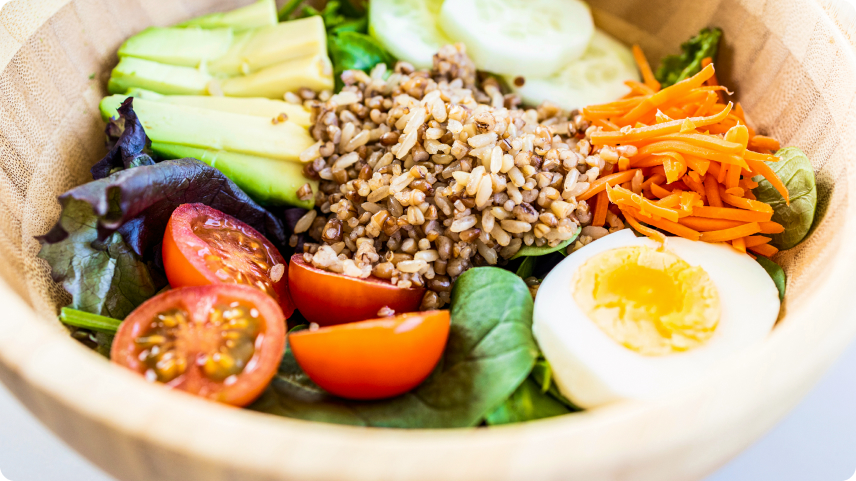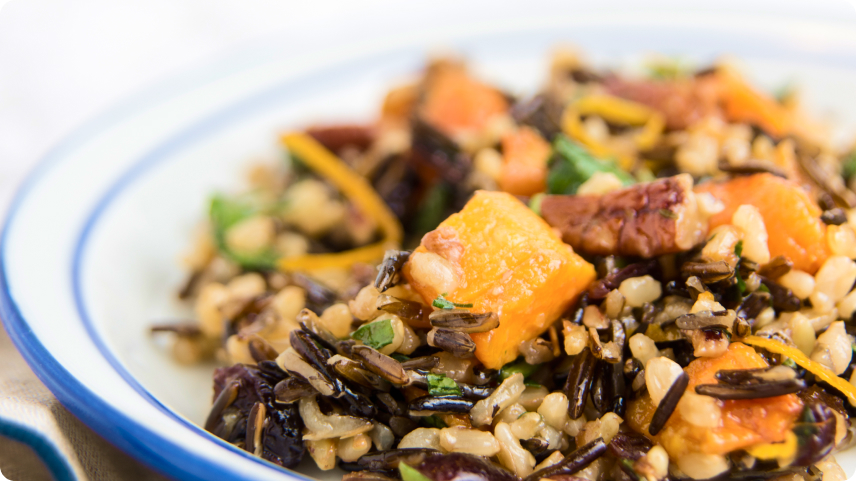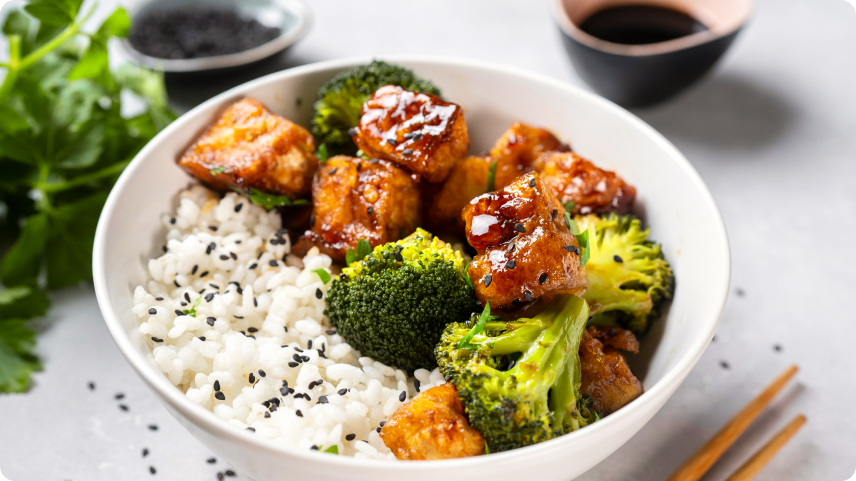What Is the Healthiest Type of Rice?

Did you know that rice provides 20% of the world’s energy from foods? Rice is a typical food many people enjoy. From plain rice to rice bowls, fried rice or rice snacks, we've all probably eaten rice at some point. If you're trying to eat healthier, you may wonder whether you should continue including rice. On top of that, there are many rice varieties, leading to a natural question that plagues many. Is there a healthiest type of rice?
In this post, we will cover the best healthy rice that you can add to your diet to help you feel full and get plenty of nutrients.
Let’s get into it.
What Makes Rice Healthy?
Rice is a nutritious grain consumed worldwide. In fact, it's so popular that its world per capita consumption is around 78.9 kg a year!
Rice is a fantastic source of carbohydrates. Carbohydrates are essential for the body because it uses them as a source of energy. They're necessary for keeping us energized. They're especially vital for active people and athletes, as their energy requirement is often higher due to daily exercise.
Some rice varieties contain plenty of fiber. Fiber is a great nutrient for gut health. It helps us feel fuller for longer, supports good gut health, and can even help us look after our hearts.
Rice is a good source of vitamins and minerals. It typically contains manganese, vitamins B, selenium and magnesium. Manganese is a trace element that supports our metabolism, blood clotting and bone formation. The B group vitamins help us obtain energy from foods and support the health of our nervous system. Selenium is essential for our thyroid function and our immunity. Magnesium is a part of many reactions in our body, from muscle contractions to blood sugar level control.
Rice can also contain plenty of phytochemicals or beneficial plant compounds that can support our health. Brown rice contains anthocyanins, which are valuable antioxidants. Rice can contain phytosterols, which can help us support healthy cholesterol levels in the blood. Polyphenols in rice may have anti-bacterial and anti-inflammatory action. Rice bran also contains some vitamin E, which is another essential antioxidant.
Is rice healthy for losing weight? It can be if used in moderation. Rice's fiber and protein content can help you feel full. Brown rice may also reduce glycemic response and support a healthy metabolism.
There are many healthy benefits of rice. However, they are typically dependent on the type of rice you consume. Let’s break down what each common type of rice has nutritionally, so that you can make informed choices.
Brown rice
During threshing, rice is separated into husk and brown rice. Brown rice contains the outermost husk, the embryo, and the endosperm. This type of rice contains plenty of fiber, good fats, phytochemicals, and B-vitamins, making it healthy. It is considered a whole grain.
One hundred grams of cooked brown rice contains 112 calories, and it contains around 2 grams of fiber and protein.
A type of brown rice that is becoming more popular in Asian countries is germinated brown rice. We add water to it to let it begin germinating. This makes it easier to digest the nutrients in brown rice and improves its texture. In addition, it changes the compounds in the rice, and new bioactive compounds, like GABA, are formed. GABA is an amino acid neurotransmitter that may have positive effects on our mood, sleep, and cognition.

Black rice
Black rice was considered a very rare type of rice that would extend the life of kings and support good health. The black color is obtained due to the high anthocyanin content in the rice bran. Black rice is healthy, providing plenty of carbohydrates. It contains minerals such as selenium, zinc, iron, calcium, and vitamins B and E. Black rice can support healthy cholesterol levels. Black rice has a slightly higher protein and fiber content than brown rice and red rice.
Red rice
Red rice varieties are typically rich in iron and zinc. They get their colors from anthocyanins, which act like antioxidants and provide plenty of health benefits. Red rice has more phytochemicals than white rice. A hundred grams of red rice contains about 8 grams of protein and 3.5 grams of fiber. This makes red rice a healthy option for those trying to support their fiber intake or those losing weight.
Purple Rice
Purple rice is another type of rice rich in anthocyanin. It exists in both glutinous and non-glutinous varieties, suitable for different cooking types. The anthocyanin content in purple rice is very dependent on its varieties. Purple rice appears to have higher amounts of arginine, asparagine, glutamine, methionine, and ornithine compared to other colored rice varieties. These amino acids are key for health, and many are essential.
One hundred grams of purple whole grain aromatic rice provides 311 calories, 13 grams of protein, and about 4 grams of fiber.
Wild rice
Wild rice has been an important North American crop for over 10,000 years. It's a different species from the rice we eat, and it grows predominantly in the Great Lakes region of the US and Canada. Wild rice is healthy and contains about 10-20% protein by weight and up to 2% fiber. It contains plenty of the B-group vitamins and vitamin E. It's a great source of beneficial plant compounds like flavonoids and phytosterols.

White rice
One of the biggest questions on everyone’s mind is this: is white rice healthy?
White rice is a staple for many people and many cultures. It is high in carbohydrates, especially starch. Compared to brown rice, it has a lower content of fiber, vitamins, and bioactive components. However, enriched white rice may compensate for the loss of certain vitamins and minerals. While white rice may spike blood sugar when consumed on its own, when paired with proteins and fats, the effect can be decreased.

Packaged Rice Blends
Let's talk about another type of rice or packaged rice. It can mean two things. There are packaged rice blends that contain multiple types of rice. These will typically contain dry rice. To understand their nutrition, it’s best to consult the packaging.
The other type of rice blend you may find is called microwavable rice. Instant rice is really convenient because it's quick to cook. However, certain blends can be high in sodium, sugar, or calories. Make sure to consult the packaging before picking out the rice.
Which type should you choose?
Now that we know what makes different types of rice nutritious, it's time to jump to the most critical question. Is there a best healthy rice?
Rice is a great source of carbohydrates, which the body uses for energy. It is also a great source of other nutrients, including vitamins and minerals, and is a staple food across many cultures.
Typically, whole grains are considered better than processed ones. You may benefit from increasing your intake of whole grain rice varieties, as they tend to have more fiber and more antioxidants.
However, white rice is also a healthy option many people across different cultures include in their daily meals. Ensure you're eating a balanced meal alongside the rice, and you'll be set.
Tips for Consuming Rice
Rice is a very versatile food, which makes it easy to consume.
To help you make the most of the nutrients in rice, it’s important to remember a few things when adding it to your meals:
- Mind your portion sizes. Rice can be a nutritious source of carbohydrates for energy. However, consuming more energy than you need may lead to weight gain. Therefore, checking your portion sizes and ensuring you're not overeating is a good idea.
- Check the rice variety. Different rice varieties require different cooking times. You may also need to rinse rice if you're cooking particular dishes. Taking these details into account can help you make rice delicious.
- Add other nutrients. Rice is an excellent base for dishes. It provides plenty of carbs and can have some fiber. However, different rice varieties may raise blood sugars quickly. It's a good idea to include other nutrients alongside your rice. Add a source of fats, protein, and veggies to help you stay fuller and make heart-healthy rice options.
- Mix it up. Include different types of rice in your weekly or monthly meal plan to capitalize on rice's different nutrient profiles.
- Experiment. Eating chicken breast with plain white rice gets old quickly. Add variety by making different rice-based dishes. Whether you add rice to a salad, make lettuce wraps with it, risotto, or even rice bowls, give your body and mind variety.
- Jump on the spice train. Your rice can be seasoned with more than just salt. Add spices when cooking rice. Many herbs and spices, like turmeric, have significant health benefits, too.
- Don't fret about arsenic. Many people worry about arsenic levels in rice. However, a World Health Organization study found that US-grown rice contains the lowest levels of arsenic compared to other countries. In addition, levels of arsenic in rice are closely monitored and won't make you sick.
- Cool your rice. If you're predominantly eating white rice, using leftover or day-old rice may be a plus. Cooling cooked rice can increase the amounts of resistant starch, which can lower the glycemic response to the rice, helping raise blood sugar levels slower.
Rice can be a great addition to your diet. For healthier options, choose black, purple, brown, or red rice varieties. They tend to contain more fiber, plant compounds, and protein than white rice. It's a good idea to consume different types of rice and make sure you're getting the recommended amount of whole grain servings a day.






